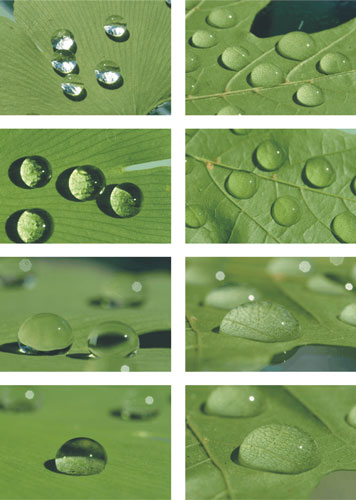Sunburned Ferns?
By Anna Lena Phillips
Optical physics provides the antidote to a gardening myth
Optical physics provides the antidote to a gardening myth

DOI: 10.1511/2010.83.122
The following question appeared on an exam for Hungarian students in 2006:
In summer, at midday sunshine, it is inadvisable to water in the garden, because the plant leaves burn. Which is the only correct explanation for this?
It would be hard to provide a correct answer—the question itself is incorrect. But it reflects a widely held horticultural belief: that watering plants in the middle of the day causes sunburn. “This is an old environmental optical problem,” says Gábor Horváth of the environmental optics laboratory at Eötvös Loránd University in Budapest. And no one had tried to solve it.

Photographs courtesy of Gábor Horváth and New Phytologist.
Horváth and his colleagues decided to do so. They describe their results in a paper published online in New Phytologist on January 8. To test what happens when rays of sunlight pass through droplets on leaves, they covered maple (Acer platanoides) leaves with small clear glass beads and exposed them to direct sun. When they scanned the leaves, sunburned spots were clearly visible, their severity increasing with the amount of time the leaves had been exposed.
As is often the case with persistent myths, the idea of plants getting sunburn “made sense.” The glass beads supported that. To find whether water would do the same, the researchers placed water drops on maple leaves, which have a smooth, non-water-repellant surface, and ginkgo (Ginkgo biloba) leaves, whose smooth surfaces repel water. The sets of leaves were exposed to sun at varying times and left until the drops had evaporated. Scans revealed no visible leaf burn.
Several factors account for this. Water has a smaller refractive index (a measure of the decrease in the speed of a wave when it passes into a new medium) than glass. Water droplets are not perfectly spherical in shape; an ellipsoid shape has less refractive power and, therefore, a longer focal length, than does a sphere. And water drops come into contact with the leaf and cool it as they evaporate.
The team also created a computer simulation of how water drops focus sunlight. Using measurements of drop shape and the elevation angle of the sun, they determined the light-collecting efficiency of the drops. This allowed them to estimate the focal region of a given drop and thus determine whether refracted sunlight would focus on the leaf surface and heat it. As it happens, for water drops resting on a horizontal leaf surface, the focal region falls on the leaf surface only at about 23 degrees solar elevation—in the early morning and late afternoon, when the sun is not intense enough to cause burn.
In a final experiment, they tested whether water drops can cause sunburn on leaves whose surfaces are covered with small hairs. The group used floating fern (Salvinia natans) leaves for this experiment; they placed water drops on the leaves and exposed them to two hours of midday sunlight. Many of these leaves were clearly burned.
“Leaf hairs can hold a water droplet at an appropriate height above the leaf so that the droplet’s focal region can fall just onto the leaf surface” and at the same time prevent the drop from providing evaporative cooling, Horváth explains. Fortunately for the floating fern, its leaf hairs are water repellant; it is likely that drops would roll off of the leaf before they could cause much burn.
Still, Horváth advises, it’s probably best not to water hairy-leaved plants in the middle of the day—and it’s not a bad idea to avoiding watering all plants at noon; doing so can introduce other kinds of physiological stress.
Humans may have something in common with hairy-leaved plants: Water droplets held by the tiny hairs on our skin might focus sunlight to cause sunburn. Horváth hopes someone will investigate. In the meantime, he is happy to have thrown some light on the subject of leaf burn. “Misbeliefs and myths rule the online literature,” he says. Raymond Lee, a meteorologist at the United States Naval Academy, agrees: “Atmospheric optical phenomena such as this present many opportunities for confusion and myth-making among generalist readers—and even a surprising number of scientists.”
Click "American Scientist" to access home page
American Scientist Comments and Discussion
To discuss our articles or comment on them, please share them and tag American Scientist on social media platforms. Here are links to our profiles on Twitter, Facebook, and LinkedIn.
If we re-share your post, we will moderate comments/discussion following our comments policy.